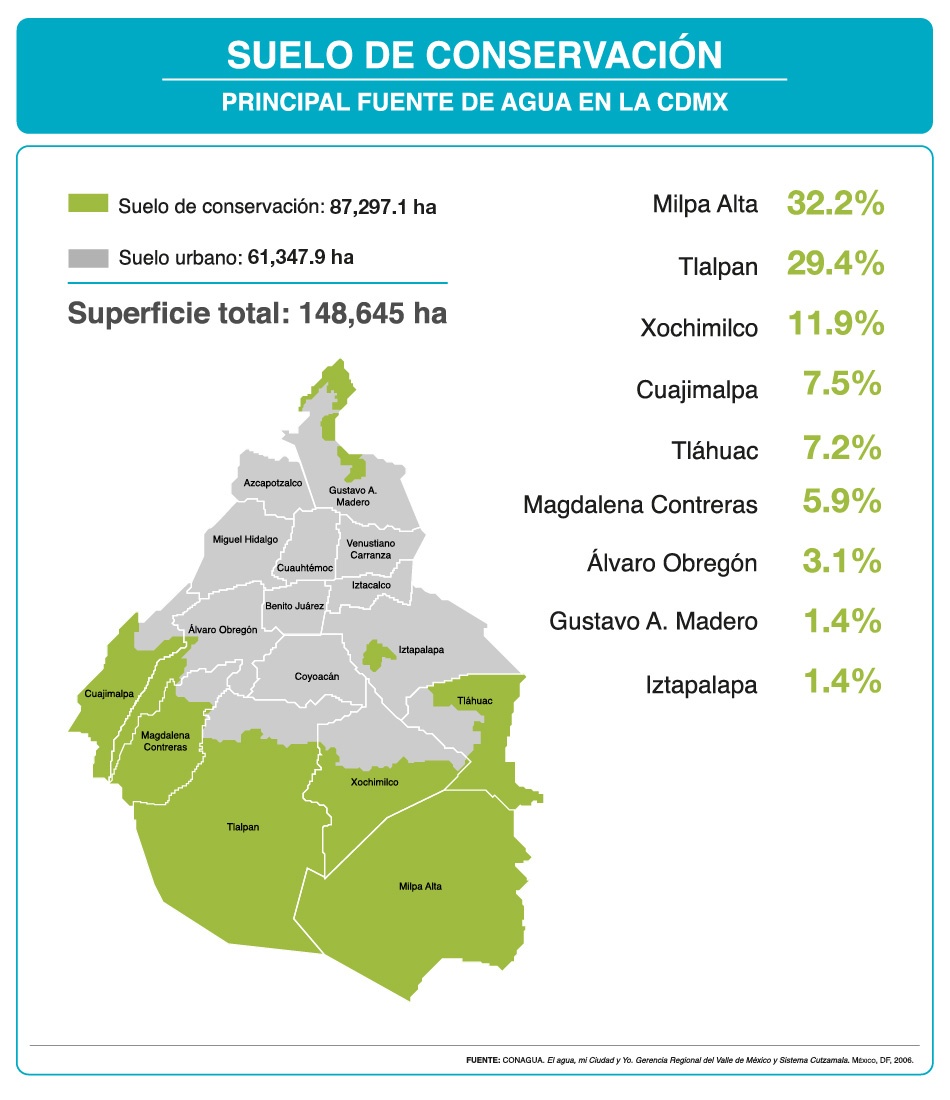
Uploaded on 2016-04-05 by Arpelaez
Urban Land The urban land has an area of 60 867.9 ha (41% of the territory) and, as its name says, it is the urban area where most of the population of the District Federal 20.4% (632.66 km2) land urban is covered by urban green areas public and private, of which 55.9% (353.65 km2) are wooded areas, and 44.1% (279.01km2), grasses and shrubs. The green areas within the urban structure are the most important areas where the inhabitants They have a constant contact with nature, and are essential in maintaining a healthy environment for the population of this city. However, currently the percentage of green areas of the city is not evenly distributed in the delegations. Conservation Land The conservation land covers 87 294.36 ha (59% of the territory) and is located mainly south and south west of the Federal District. In this area agriculture, forestry and livestock activities are still carried out. ![][1] Source: Gobierno CDMX Ecosystem Services. ***Provisioning services*** **Fresh water: Magdalena River and Eslava River** The Magdalena River rises to 3 600 m, in the place of Cieneguillas, and descends steep slopes touring the natural landscapes of the basin along 14.8 km; then delves into the urban area of the city that runs 13.4 km before emptying into the collector Rio Churubusco Avenue. Approximately 52.5% of the river takes place in natural area, and 47.5% in urban areas. The tributaries that feed it are of a different nature in the two areas: in the upper part of the basin, the river fed by springs and surface runoff; in the city, is fed into a first portion of the mixture of natural runoff with wastewater discharges, as well as the contribution, under the same conditions, the Eslava river. The sharp exchange of moisture between rainy seasons and dry causes major differences in cyclical operation, the quantity and quality of the river water. One of the major strengths of the Magdalena River is its natural area in good condition. Unlike other forests near the Federal District, which surrounds the Magdalena river presents a well-preserved vegetation cover, as well as a representative biodiversity of temperate forests and a set of ecosystem services that benefit the entire city. The location of the Magdalena River in the central part of the Gaza Volcanic Belt, rich in species diversity, allows the basin is an important refuge of biological and ecological wealth available to Mexico City. The basin of the Eslava River, the largest tributary of the Magdalena, is a natural space in its middle and upper still maintains an acceptable level of preservation of its environmental capital while the naturalness of the river is considered to be in good condition and springs are little tatty. The water flow of the river is enough in the rainy season, which favors the possibility of creating new schemes for sustainable use of downstream water during this season, in addition to the recovery of areas subject to environmental risk. From the point of view of natural resource management, there is a community organization (San Nicolas Totolapan Ejido) dedicated to the conservation of environmental capital, which coordinates programs of reforestation, forest sanitation, flood control and fire fighting. ![][2] Source: Agua, rios y pueblos ***Regulating services*** **Local climate and air quality:** The Metropolitan Area of Mexico has significant air pollution. The efforts made during the 90s seem to influence the trend of pollutants; however, with the exception of lead, sulfur dioxide and carbon monoxide pollution levels are still above the air quality standards. Air pollution has negative effects on human health, such as: eye irritation, respiratory diseases, cardiovascular effects and premature death. Moreover, high levels of pollution can affect economic activity, since the implementation of the Program Environmental Contingencies (PCA) restricts the activities of vehicular manufacturing, utilities and. Air pollution is the result of various physical processes, with some exceptions current levels of air pollution in the Metropolitan Area of Mexico exceed the permitted standards. In the introduction of the exercise, we can see the green areas distribution in Mexico City, the percentage of green areas of the city is not evenly distributed in the delegations and they affect in the air quality in the whole City. ![][3] Source: ndmx.co ***Habitat or Supporting services*** **Habitats for species:** As part of the Basin of Mexico, DF It has climatic, topographic and soil characteristics that make possible the existence of important ecosystems. It is also known that the D.F. It has a large number of endemic species, ie species whose distribution is limited to a restricted area. Soil conservation in natural ecosystems of great importance are located, with types of vegetation and coniferous forests, mixed, oak, cloud, desert scrub and water and underwater (lake area in Xochimilco and Tláhuac) vegetation. In addition, the height that is the DF It has also led to the development of natural grasslands (zacatonales). Of vertebrate species that inhabit the soil conservation DF 24 species of amphibians, 56 of reptiles, 59 mammals and 211 birds are reported. These species include the zacatuche, serrano sparrow and the axolotl of Xochimilco, which are endemic to Mexico City and its surroundings. In the urban soil, vegetation distributed in forests, parks, gardens, canyons, roundabouts, medians and open spaces is home to many exotic and native species. ![][4] Source: Sedema. Gobierno CDMX ***Cultural services*** **Recreation and mental and physical health.** Mexico City offers excellent options for spending free time. Entertainment in Mexico City includes activities like visiting parks and forests, cinemas, theaters, museums, sporting events such as football, baseball, popular races, and concerts. Although not all the colonies of restaurants and cafes is very wide. ![][5] Source: Defe.mx [1]: https://edxuploads.s3.amazonaws.com/14598540548337298.jpg [2]: https://edxuploads.s3.amazonaws.com/14598541702764065.jpg [3]: https://edxuploads.s3.amazonaws.com/14598543279508634.jpg [4]: https://edxuploads.s3.amazonaws.com/14598544074545249.png [5]: https://edxuploads.s3.amazonaws.com/14598544737127213.jpg